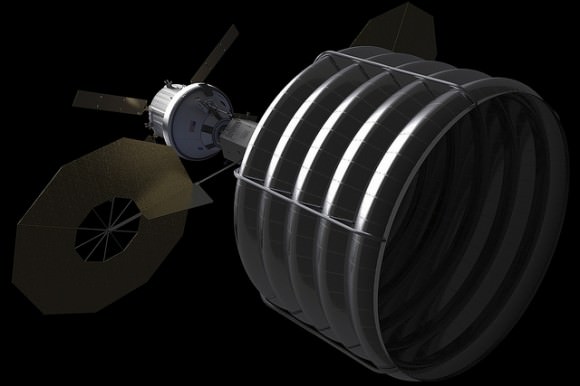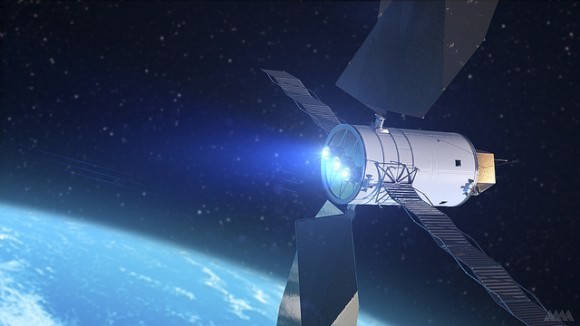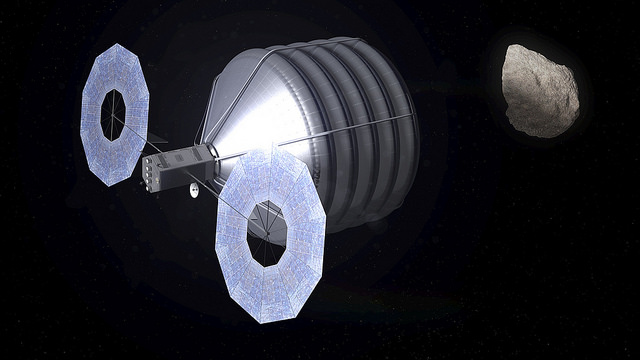NASA’s FY2014 budget proposal includes a plan to robotically capture a small near-Earth asteroid and redirect it safely to a stable orbit in the Earth-moon system where astronauts can visit and explore it. A spacecraft would capture an asteroid — which hasn’t been chosen yet, but would be about 7 meters (25 feet) wide — in 2019. Then using an Orion space capsule, a crew of about four astronauts would station-keep with the space rock in 2021 to allow for EVAs for exploration.
NASA has released new images, a video and more information about the mission.
They say that performing all the elements for the proposed asteroid initiative “integrates the best of NASA’s science, technology and human exploration capabilities and draws on the innovation of America’s brightest scientists and engineers.” The mission will combine existing technology along with capabilities being developed to find both large asteroids that pose a hazard to Earth and small asteroids that could be candidates for the proposed mission. NASA says this initiative will help accelerate technology development activities in high-powered solar electric propulsion and take advantage the Space Launch System rocket and Orion spacecraft currently being built, “helping to keep NASA on target to reach the President’s goal of sending humans to Mars in the 2030s.”
Here’s more of NASA’s info:
When astronauts don their spacesuits and venture out for a spacewalk on the surface of an asteroid, how they move and take samples of it will be based on years of knowledge built by NASA scientists and engineers who have assembled and operated the International Space Station, evaluated exploration mission concepts, sent scientific spacecraft to characterize near-Earth objects and performed ground-based analog missions.
As early as the 1970s, NASA examined potential ways to use existing hardware to visit an asteroid to understand better its characteristics. On the International Space Station, scientific investigations and technology demonstrations are improving knowledge of how humans can live and work in space. The agency also has examined many possible mission concepts to help define what capabilities are needed to push the boundaries of space exploration.
During the early space shuttle flights and through assembly of the space station, NASA has relied on testing both in space and on Earth to try out ideas through a host of analog missions, or field tests, that simulate the complexity of endeavors in space.

Through 16 missions in the National Oceanic and Atmospheric Administration’s underwater Aquarius Reef Base off the coast of Key Largo, Fla., aquanauts have tested techniques for human space exploration. These underwater tests have been built upon the experience gained by training astronauts in the Neutral Buoyancy Laboratory at NASA’s Johnson Space Center in Houston to assemble and maintain the space station. The NASA Extreme Environment Mission Operations (NEEMO) 15 and 16 missions in 2011 and 2012, respectively, simulated several challenges explorers will face when visiting an asteroid, including how to anchor to and move around the surface of a near-Earth object and how to collect samples of it.
NASA also has simulated an asteroid mission as part of its 2012 Research and Technology Studies ground test at Johnson. During the simulation, a team evaluated how astronauts might do a spacewalk on an asteroid and accomplish other goals. While performing a spacewalk on a captured asteroid will involve different techniques than the activities performed during recent analog exercises, decisions made about ways to best sample an asteroid will be informed by the agency’s on-going concept development and past work.

Scientific missions also have investigated the nature of asteroids to provide a glimpse of the origins of the solar system. From the Pioneer 10 spacecraft, which in 1972 was the first to venture into the Main Asteroid Belt, to the Dawn mission, which recently concluded its investigations of asteroid Vesta and is on its way to the dwarf planet Ceres, NASA’s forays help us understand the origins of the solar system and inform decisions about how to conduct missions to distant planetary bodies. Scientists both at NASA and across the world also continue to study asteroids to shed light on their unique characteristics.
As NASA ventures farther into the solar system, the agency continues to simulate and evaluate operations and technical concepts for visiting an asteroid.
Source: NASA


I like this. First it is the right-sized bite. Second it is cool. Third, what secrets await. Just think, a whole world to digest. Whole chapters of asteroid (and comet) science await.
Moreover, the world-wide market for asteroid bits remains unplumbed. I hear the dust has natural viagra-like properties. If it last more than 4 hours you should brag to your mates.
Score for NASA. Who’s baby is this? Who thunk it up first? Could it be done on international scale? Why not open-source this one?
I like it. Clearly the only way to get congress critters on board is to pitch the project in such a way that it impacts their sexuality. Asteroid dust makes you go for hours AND it makes you larger. It does this through amino-isotopes that permeate your chakra. Some people will be able to detect this aura change and you will be seen as a powerful leader among men. North Korean leaders will be amazed at your excessive virility.
Sorry for the de-railing (and the made up noun), This really is a great project, and I would hope that its obvious that the advances in science and technology and the experience gained make this project very valuable. Rasmus mentions spacemining as one example of a possible (probable?) beneficiary.
What if the asteroid is off balance? That craft will need a lot of fuel to keep correcting.
no air = no off balance drag?
Drag has nothing to do with it – center of mass does. If that asteroid is off center then the craft will have to use extra jets in the opposite direction to compensate.
Why would a craft need to compensate? It is in space, it does not matter in what direction your are flying.
The only thing that needs to happen is that the thrust vector has to go through the center of mass, but it doesn’t have to be at the center of the craft. Basically, it will “crab” a little bit, but this is not a problem
Curious. Why push instead of drag (re mass center)?
I like the multiple mission service module!
“Hey you guys! We really like that asteroid you showed us…Umm… Do you think you could go out and get this one?”
Some observations:
This seems a bit pointless when a robotic lander could probably give just as much information.
I’m sure it will get delayed until the next administration takes office, who will promptly cancel the program when it’s 95% ready.
They are assuming the asteroid is rocky, when I’d bet a lot of them are more like loose piles of rubble. That may complicate things, so they will have to be very choosy.
They also better be careful of those giant worms that live in asteroid caves.
An asteroid of that size has to be somewhat solid, it has just about zero gravity and couldn’t hold rubble together.
And no, a robotic lander could not give the same info.
Sample return should be a part of a lander mission. But then again, only small samples from roughly the same spot would be returned.
Also, the technology to capture asteroids could be VERY useful for future spacemining.
Thanks, but isn’t that a matter choice, resources and design skill?
Funding favors this earlier use of Orion for a manned AstroVac mission, so those political leaders whose districts benefit the most have a better chance of fighting off Orion’s early cancellation.
Meanwhile, robotic missions to de-orbit satellite-threatening space junk, to interdict Earth threatening asteroids, or to establish in-space propellant depots etc, all take a back seat to the narrower self-interests of those holding NASA’s purse strings.
It may be a good technology demonstration which can be used for future asteroid mining mission or can also be a good practice to deflect asteroid coming towards earth. But I have question – what will happen to this asteroid after the experimentation over? Will it remain as a small moon of our own moon? Then there may be a threat , orbit might be destabilized due to earth attraction within few hundreds or thousands years and may cause threat to earth or may hit moon will cause problem to our future moon colony. I hope NASA has answer – they should explain.
At that size it would not survive atmospheric reentry. Even if we didn’t take it apart first while studying it.
Secondly, they would most likely dump it onto the moon when their science is “complete” specifically to avoid it becoming a navigation hazard later.
Unless we strap a heat-shield onto it 😉
Moreover, the world-wide market for asteroid bits remains unplumbed. I hear the dust has natural viagra-like properties. If it last more than 4 hours you should brag to your mates.
Didn’t the brain bugs from Starship Troupers use this technology? Non-nuclear, nuclear wepons… watch out north korea!
There are too many variables in this mission to say it’s chances of success are more than 50% . The approach vector to “catch” the asteroid into the inflated “mitt” needs to be exact. Even a 1% deviation can be fatal for the mission. Since it looks like the “mitt” is inflated Bigelow style , explosive decompression is also likely if the asteroid is sharp/abrasive enough,
But with enough $$$ , any mission has a fighting chance. The long term payoff with possible noble and rare metals is also nice. No tribals or “land owners” to deal with over mining rights and other pesky stuff like that. Space is a wide open winner takes all field right now.